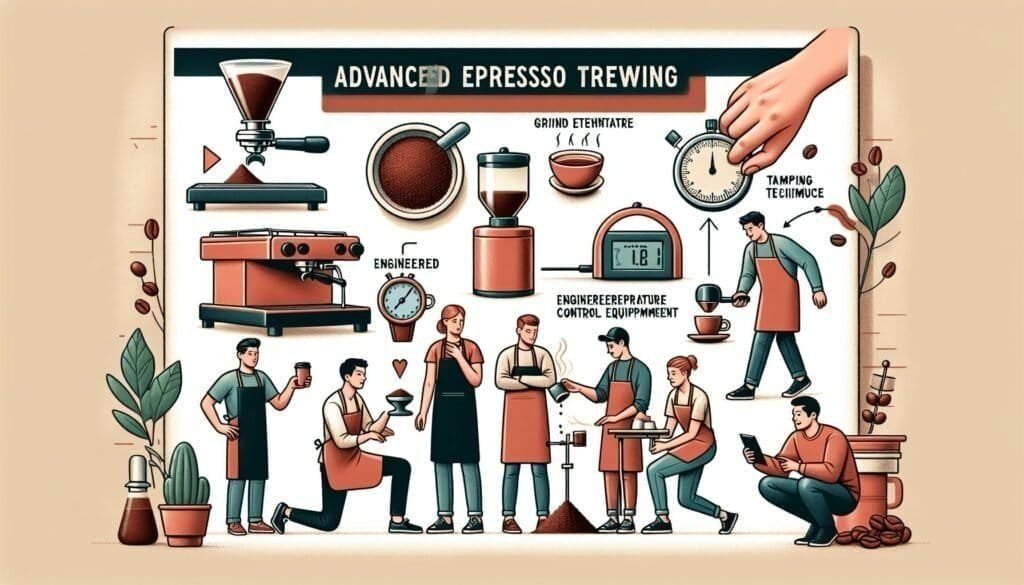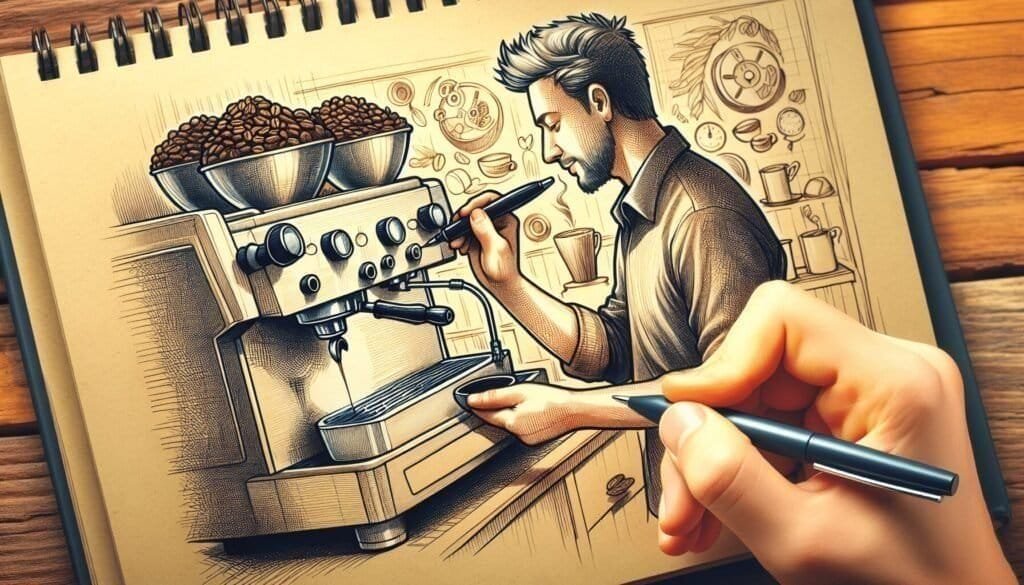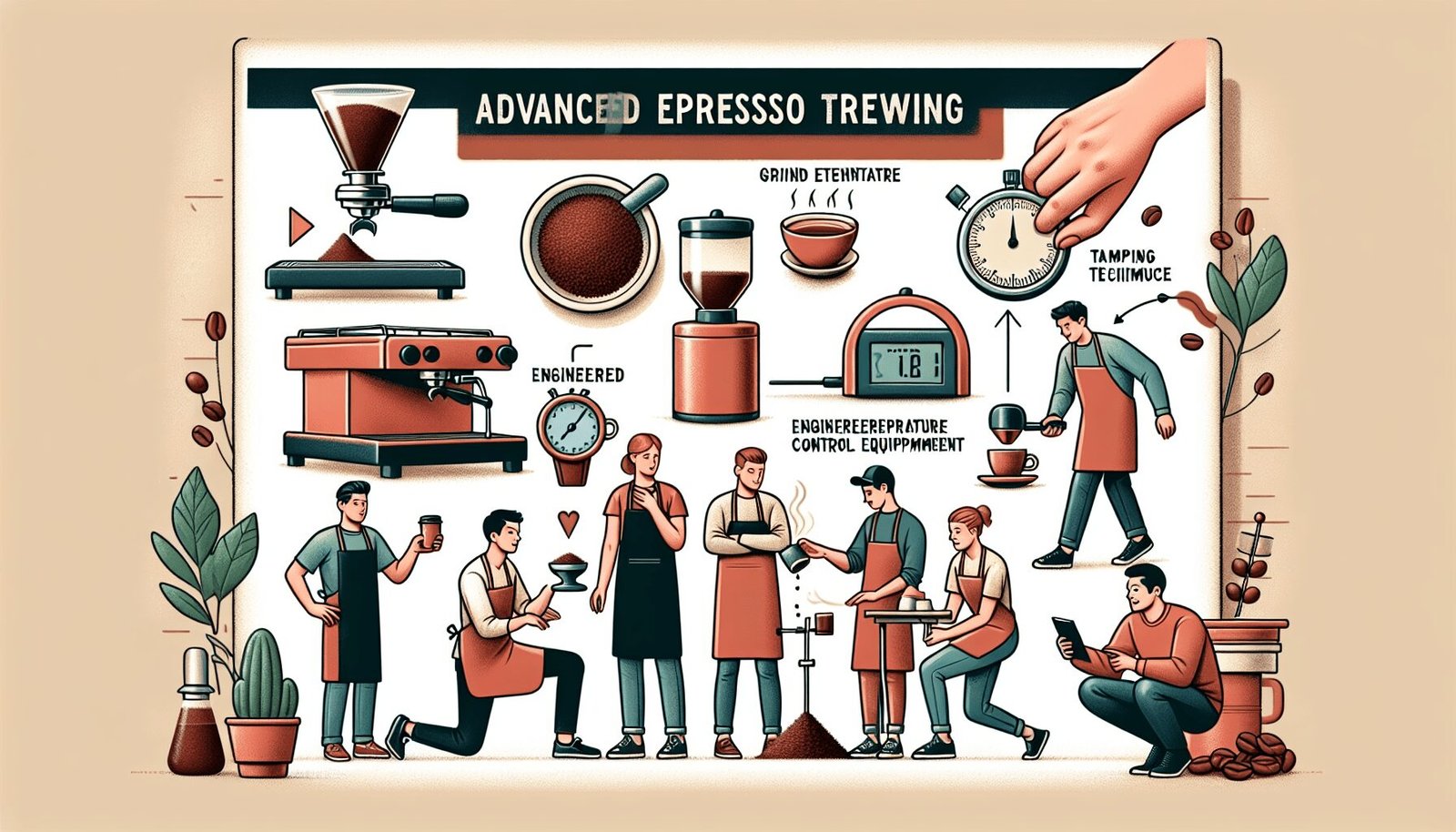If you’re a coffee enthusiast looking to take your brewing skills to the next level, then “Advanced Espresso: Essential Tips for Trouble-Free and Perfect Brewing” is the article for you. Whether you’re a seasoned barista or just starting out, this article will provide you with valuable insights and techniques to achieve that elusive cup of espresso perfection. From grind size to temperature control, this comprehensive guide will ensure that every shot you pull is consistently delicious and free from any brewing mishaps. So grab your favorite mug and get ready to embark on a journey to coffee greatness.

Understanding Espresso Basics
What is Espresso?
Espresso is a concentrated form of coffee that is brewed by forcing hot water under high pressure through finely ground coffee beans. It is known for its strong flavor and rich, creamy consistency. Unlike regular drip coffee, which is brewed by allowing water to pass through the coffee grounds, espresso is brewed by rapidly extracting the flavors and aromas from the coffee beans.
The History of Espresso
The history of espresso dates back to the 19th century in Italy, where it was first invented. The exact origins are a bit unclear, but it is believed that the development of espresso machines played a major role in popularizing this brewing method. Over the years, espresso has evolved and gained popularity worldwide, with various brewing techniques and recipes emerging.
The Different Varieties of Espresso
There are several different varieties of espresso, each with its own unique characteristics and flavor profiles. Some of the popular variations include:
- Traditional Espresso: This is the classic Italian style espresso, known for its balanced flavor and full-bodied taste.
- Ristretto: A shorter espresso shot with a more concentrated flavor, achieved by using less water during the brewing process.
- Lungo: A longer espresso shot that is brewed with more water, resulting in a milder flavor profile.
- Macchiato: An espresso shot with a small amount of milk or foam added, creating a bittersweet taste.
- Americano: A diluted espresso shot with hot water added, providing a smoother and milder taste.
Equipment you’ll Need
Choosing the Right Espresso Machine
Choosing the right espresso machine is crucial for brewing the perfect cup of espresso. There are various types of espresso machines available, including manual, semi-automatic, and fully automatic machines. Consider factors such as your brewing preferences, budget, and desired level of control when selecting an espresso machine. It is also important to invest in a machine that has the necessary features, such as temperature control, pressure gauge, and a high-quality portafilter.
Ideal Coffee Grinder for Espresso
A high-quality coffee grinder is essential for grinding coffee beans to the perfect consistency for espresso. Burr grinders are generally recommended for espresso brewing, as they offer greater control and precision. Look for a grinder that allows you to adjust the grind size to achieve the desired extraction. Consistency in grind size is key to ensuring an even extraction and a well-balanced flavor in your espresso.
Importance of Quality Water Filter
The quality of water used in brewing espresso has a significant impact on the taste and overall quality of the final cup. Using a high-quality water filter is crucial to remove impurities and ensure that the water used is free from chlorine or minerals that can interfere with the flavors of the coffee. Look for filters that are specifically designed for espresso brewing and regularly replace them according to the manufacturer’s guidelines to maintain optimal water quality.
Beans Selection: The Heart Of Espresso
Understanding the Coffee Varieties
The choice of coffee beans is a critical factor in determining the flavor and aroma of your espresso. There are various coffee varieties available, including Arabica and Robusta, each with its own unique characteristics. Arabica beans are generally favored for their complex flavors and acidity, while Robusta beans are known for their bold, bitter taste and higher caffeine content. Experiment with different coffee varieties to find the flavor profile that best suits your preferences.
Choosing the Right Roast for Espresso
The roast level of the coffee beans also plays a significant role in the flavor profile of the espresso. Different roast levels, such as light, medium, and dark, result in varying flavors and aromas. Lighter roasts preserve the natural flavors and acidity of the beans, while darker roasts develop more caramelized, bittersweet notes. Consider experimenting with different roast levels to find the perfect balance that complements your desired espresso taste.
Buying Fresh Espresso Beans
To ensure the best quality espresso, it is essential to use freshly roasted coffee beans. This is because coffee beans begin to lose their flavors and aromas shortly after being roasted. Look for coffee beans with a roast date clearly indicated on the packaging, and aim to use them within two to three weeks of being roasted. Buying beans from a reputable and trustworthy source will also help ensure their freshness and quality.
Precision in Coffee Grinding
The Impact of Grind Size on Espresso
The grind size of the coffee beans has a significant impact on the extraction process and the resulting flavor of the espresso. Finer grinds generally result in a stronger and more concentrated shot, while coarser grinds yield a milder and less intense taste. It is important to adjust the grind size based on the desired extraction time and the characteristics of the coffee beans. Experimentation and fine-tuning are key to achieving the perfect grind size for your espresso.
Achieving the Perfect Grind Consistency
Consistency in grind size is crucial for an even extraction and a well-balanced flavor in your espresso. Inconsistent grinds can lead to over-extraction or under-extraction, resulting in a bitter or weak-tasting cup of espresso. Invest in a high-quality coffee grinder with precise settings and regularly clean and maintain it to ensure consistent performance. Periodically checking the grind consistency by examining the particles can also help you make adjustments and achieve the desired results.
Tips for Adjusting Grinder Settings
Adjusting the grinder settings can be a delicate process that requires patience and experimentation. Start by making small adjustments and closely monitor the resulting changes in extraction time and flavor. If the extraction is too fast, resulting in a weak or sour taste, try using a finer grind. Conversely, if the extraction is too slow, resulting in a bitter taste, try using a coarser grind. Keep a record of your adjustments to establish a reference point for future brews.

Mastering the Art of Dosing
Understanding the Concept of Dosing
Dosing refers to the measurement of the coffee grounds used in each espresso shot. It is important to maintain consistency in dosing to ensure that each shot has the same strength and flavor profile. Dosing is typically measured in grams, with the standard dose for a single shot of espresso ranging from 18 to 20 grams. Understanding the concept of dosing and the importance of consistency will help you control the variables and achieve a well-balanced extraction.
How to Measure the Right Amount of Coffee
Measuring the right amount of coffee for each espresso shot requires precision and accuracy. Invest in a digital scale to ensure precise measurements. Start by weighing the portafilter, then add the desired amount of coffee grounds. Distribute and level the grounds evenly before tamping. Consistent dosing will result in consistent extraction, allowing you to fine-tune other variables such as grind size, extraction time, and flavor.
Troubleshooting Common Dosing Issues
Inconsistent dosing can lead to variations in extraction and flavor in your espresso. If you notice issues such as channeling (water finding paths of least resistance) or uneven extraction, it may be a sign of improper dosing. Ensure that the coffee grounds are evenly distributed and level before tamping. Adjust the dosing amount as needed, and closely monitor the resulting extraction to identify and troubleshoot any issues.
Tamping: A Key Step to a Great Espresso
What is Tamping and Why it is Important
Tamping is the process of firmly compressing the coffee grounds in the portafilter to create an even and consistent surface. This step is crucial for ensuring that the water flows evenly through the coffee grounds during extraction. Proper tamping helps create resistance, allowing the water to extract the flavors and aromas effectively. Tamping also promotes even extraction and ensures that the water doesn’t channel through the coffee grounds, resulting in a balanced and well-extracted espresso shot.
Techniques for Effective Tamping
There are various techniques for tamping, but the key is to apply even pressure and create a level and compact coffee bed. Start by distributing the coffee grounds evenly in the portafilter basket. Use a tamper with a flat and level base that matches the diameter of the basket. Apply firm and vertical pressure, avoiding any twisting or tilting motions. The aim is to achieve a consistent and level surface that promotes uniform extraction.
Troubleshooting Tamping Problems
If you encounter tamping problems, such as uneven extraction or channeling, it may be a sign of improper tamping technique. Ensure that you distribute the coffee grounds evenly and maintain a consistent tamping pressure. If you consistently encounter issues, consider checking the alignment of your espresso machine’s portafilter and basket, as this can affect the tamping process. Experiment with different tamping techniques and observe the resulting extraction to identify and address any potential issues.
The Extraction Process
Understanding Extraction
Extraction is the process of extracting the desirable flavors and aromas from the coffee grounds. It is a delicate balance between the soluble compounds in the coffee and the water used in the brewing process. The goal of extraction is to achieve a well-balanced cup of espresso, with a harmonious combination of sweetness, acidity, and bitterness. Understanding the factors that affect extraction, such as grind size, water temperature, and duration, will help you fine-tune your brewing technique and achieve the desired flavors.
How Long Should Extraction Take?
The ideal extraction time for espresso typically ranges from 25 to 30 seconds. This timeframe allows for the desirable compounds to be extracted while minimizing the extraction of undesirable compounds that can lead to over-extraction or bitterness. However, the specific extraction time may vary depending on the coffee beans, grind size, and personal preferences. It is important to experiment and taste the espresso to determine the optimal extraction time for your desired flavor profile.
Signs of Under-extraction and Over-extraction
Under-extraction and over-extraction are common issues that can affect the taste and quality of your espresso. Under-extraction occurs when the water doesn’t extract enough of the desirable compounds from the coffee, resulting in a weak and sour taste. Signs of under-extraction include a thin and watery body, lack of sweetness, and a quick extraction time. Over-extraction, on the other hand, happens when too much of the undesirable compounds are extracted, leading to a bitter and harsh taste. Signs of over-extraction include a dark and heavy body, excessive bitterness, and an extended extraction time. Adjusting variables such as grind size, extraction time, and water temperature can help address these issues and achieve a balanced extraction.
Perfecting the Water Temperature for Espresso
How Temperature Affects Espresso Brewing
Water temperature plays a crucial role in the extraction process and the resulting flavors of your espresso. The ideal temperature for brewing espresso is typically between 195 to 205 degrees Fahrenheit (90 to 96 degrees Celsius). Water that is too hot can result in over-extraction and a bitter taste, while water that is too cold can lead to under-extraction and a sour taste. Consistency in water temperature is crucial for maintaining the desired flavor profile. Invest in an espresso machine with accurate temperature control and regularly calibrate and monitor its performance.
Finding Ideal Brewing Temperature
Achieving the ideal brewing temperature requires precision and control. Allow your espresso machine to warm up and stabilize before brewing to ensure consistent water temperature. If your machine doesn’t have precise temperature control, you can make adjustments by factors such as pre-warming the portafilter or using different brewing techniques. Experimentation and observation are essential in determining the optimal brewing temperature for your desired espresso flavors.
Problems Caused by Incorrect Temperature
Incorrect water temperature can have several negative effects on your espresso. Water that is too hot can lead to over-extracted and bitter flavors, overpowering the unique characteristics of the coffee beans. On the other hand, water that is too cold may result in under-extracted and sour flavors, lacking the depth and complexity of a well-extracted espresso. Inconsistent water temperature can also affect the overall consistency and quality of your brew. It is important to pay attention to the water temperature and make adjustments as necessary to achieve the desired flavors and balance in your espresso.
Maintaining Your Espresso Machine
Cleaning Your Espresso Machine Regularly
Regular cleaning and maintenance of your espresso machine are essential for ensuring its longevity and optimal performance. Follow the manufacturer’s instructions for cleaning and descaling, and regularly wipe down the external surfaces to remove any dirt or coffee residue. Clean the portafilter, shower screen, and group head regularly to prevent the buildup of coffee oils and other contaminants. A clean machine will not only produce better-tasting espresso but also prevent any potential issues or malfunctions.
Decalcifying the Espresso Machine
Decalcifying your espresso machine is an important step in maintaining its performance and preventing the buildup of mineral deposits in the internal components. Use a specialized descaling solution and follow the instructions provided by the manufacturer. The frequency of decalcification will depend on the hardness of your water and the usage of the machine. Regular decalcification will ensure that your machine continues to brew consistently and efficiently, resulting in better-tasting espresso.
Regular Maintenance Check-Up
Periodic maintenance check-ups are recommended to ensure that your espresso machine is functioning properly. This may involve inspecting and replacing worn-out parts, checking for leaks, and calibrating the machine’s temperature and pressure settings. Regular maintenance will help identify any potential issues early on and prevent them from affecting the quality of your espresso. If you are not comfortable performing maintenance tasks yourself, it is advisable to seek professional assistance from a qualified technician.
Advancing Your Espresso Skills
Learning to Pull The Perfect Shot
Pulling the perfect shot of espresso requires practice, patience, and a keen understanding of the brewing process. Experiment with different variables such as grind size, dosing amount, extraction time, and water temperature to fine-tune your technique. Pay attention to the flavors and aromas, and make adjustments based on your taste preferences. Take notes and record your brewing parameters to establish a reference point for future brews. With time and practice, you will develop the skills and expertise to consistently pull excellent shots of espresso.
Steaming and Frothing Milk for Latte and Cappuccino
If you enjoy milk-based espresso drinks such as lattes and cappuccinos, mastering the art of steaming and frothing milk is essential. The process involves creating microfoam by injecting steam into the milk, resulting in a creamy and velvety texture. Pay attention to the steam wand positioning, the angle of the milk pitcher, and the integration of air to create the desired level of froth and texture. Practice different techniques and experiment with different milk types to achieve the ideal consistency and taste for your desired drink.
Creating Latte Art
Latte art is the art of creating visually appealing designs on the surface of a latte or cappuccino using milk foam. It requires mastering the techniques of steaming milk and pouring it into the espresso with precision and control. Starting with simple designs such as hearts or rosettas, gradually progress to more complex patterns and designs. Latte art adds an aesthetic touch to your espresso creations and showcases your skill and creativity as a barista.
In conclusion, understanding the basics of espresso brewing is essential for achieving the perfect cup of espresso. From selecting the right equipment and beans, to mastering the techniques of grinding, dosing, and extraction, each step plays a significant role in the flavor and quality of the final cup. With knowledge, practice, and a touch of creativity, you can elevate your espresso brewing skills and enjoy the art and science of crafting the perfect espresso. So grab your espresso machine, grind some fresh beans, and embark on a journey of flavor and discovery. Cheers to your espresso adventures!




